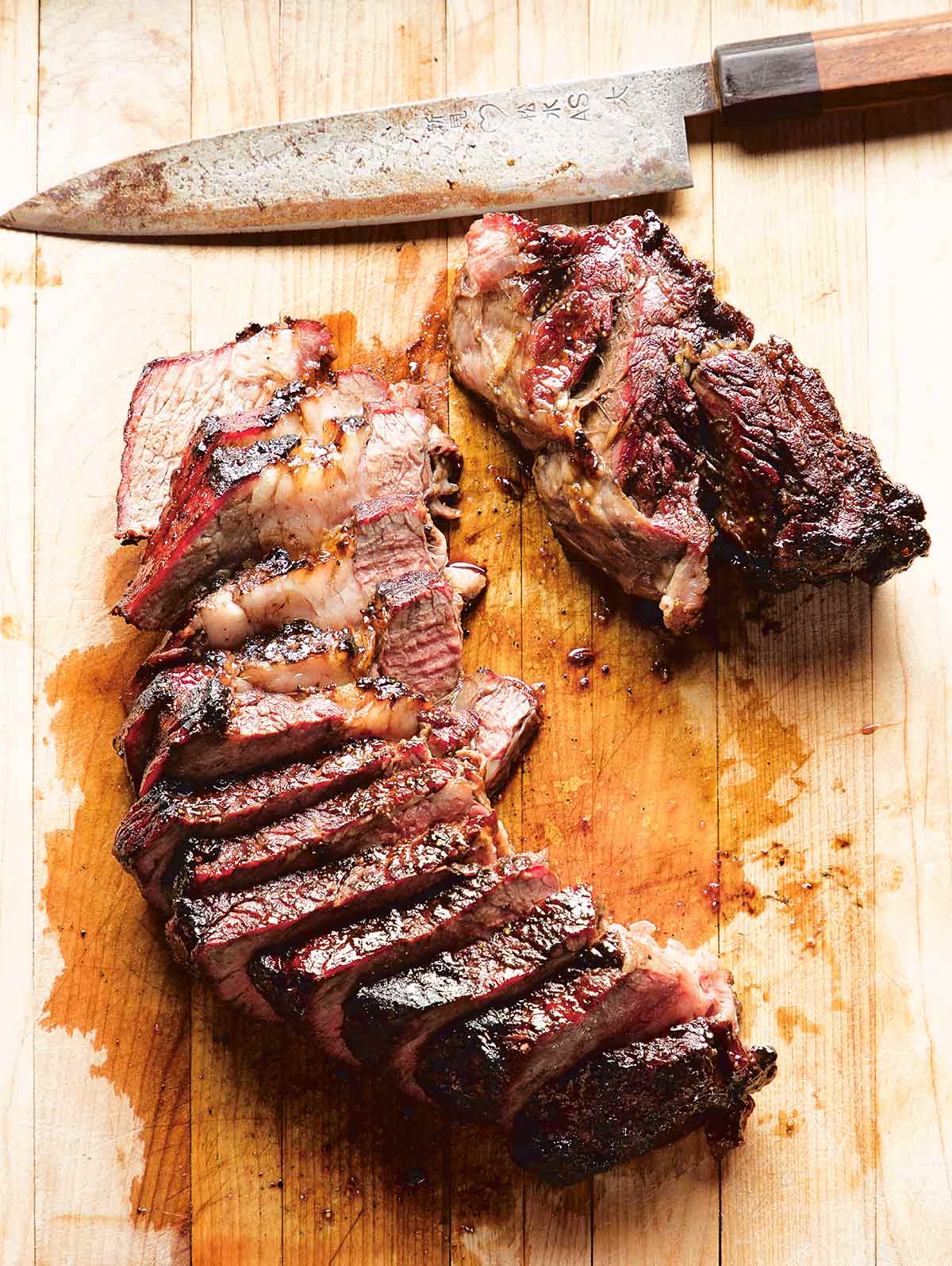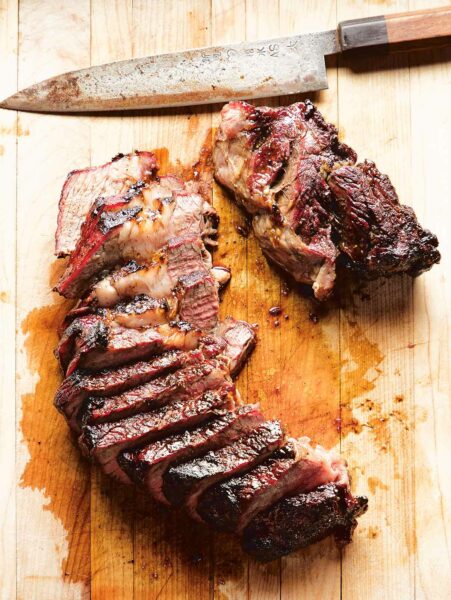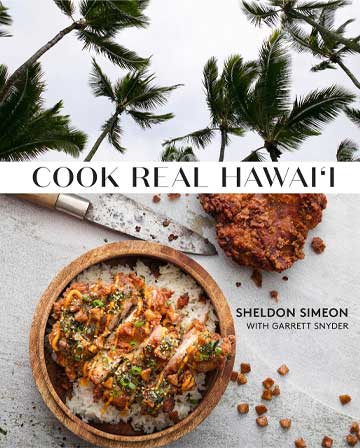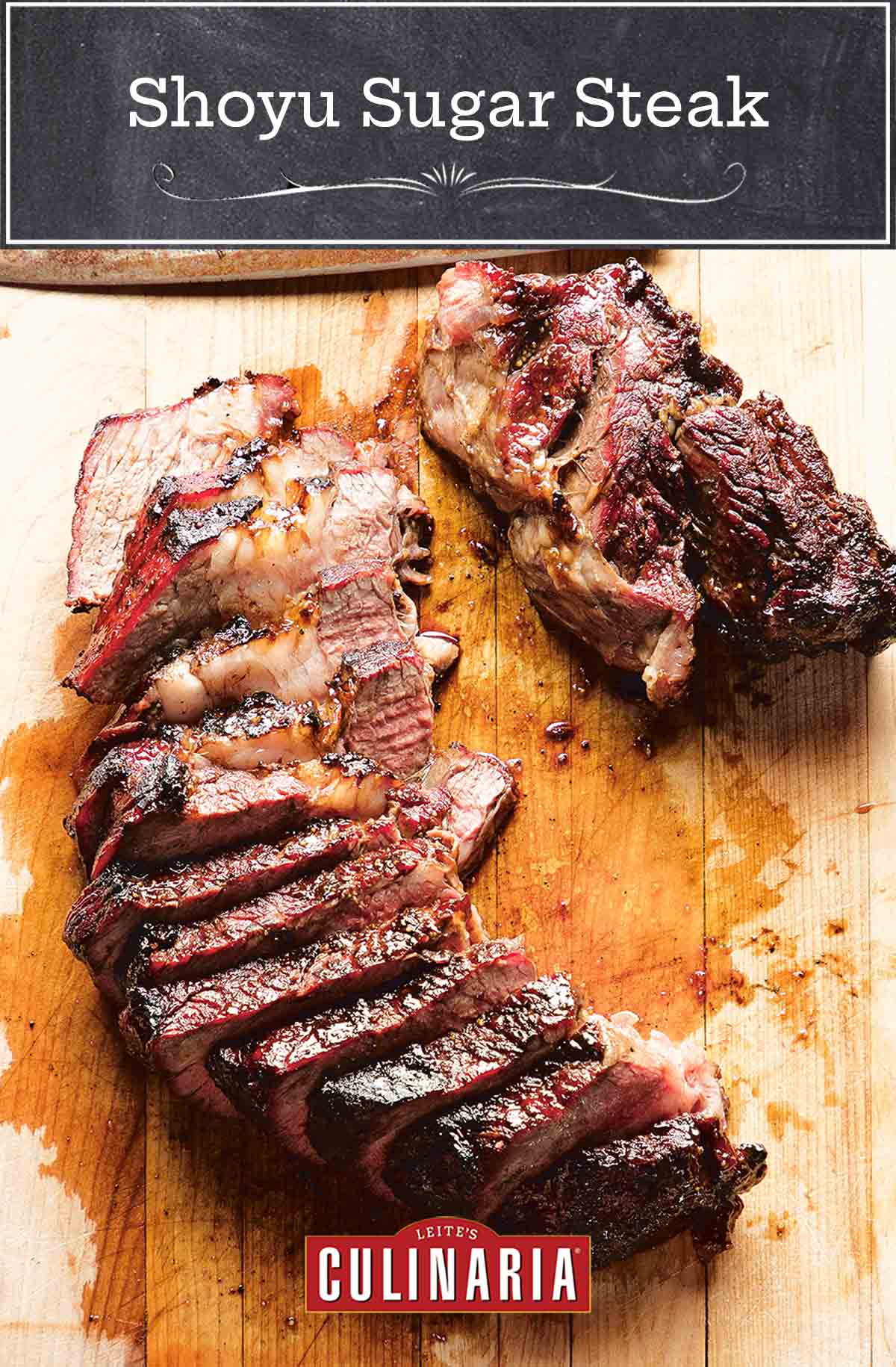
I like to think of shoyu and sugar as the mother sauce of local cuisine. Mixed together in sweet and salty balance, “shoyu sugar” forms the foundation for a number of dishes, from Chicken Hekka to Okinawa Pig’s Feet. The combination makes sense on a cultural level as much as on a culinary one: Sugarcane was the economic lifeblood of Hawai‘i for generations, while shoyu is the one seasoning we use in Hawai‘i more than any other.
Want to Save This?
The idea for this recipe came about when I faced a very specific conundrum. I love the simplicity of grilling a thick steak on my backyard grill. But if I wanted to season it with shoyu sugar, I’d have to marinate it, which would change the texture of the meat. Brushing the steak with shoyu sugar while on the grill didn’t work great either, since the liquid drips off without imparting much flavor.
The solution I came up with was a take on Japanese tare, a basting sauce thickened with brown rice that’s been toasted and pulverized. The rice powder adds a pleasant nuttiness, but more importantly, it helps the shoyu sugar cling to the steak, so you end up with a gorgeous caramelized crust. With this method, any steak at least 3/4-inch thick will work, including the usual rib eye, New York strip, T-bone, top sirloin, flank steak, etc.–Sheldon Simeon

Shoyu Sugar Steak
Ingredients
- 3 pounds boneless chuck roast or steaks of choice, cut about 1-inch (25 mm) thick
- Garlic salt
- 1/2 cup raw brown rice or barley*
- 1 cup mirin
- 1/2 cup sake
- 1 cup shoyu (soy sauce)
- 1/2 cup loosely packed light brown sugar
- 2 tablespoons apple cider vinegar
- 6 cloves garlic, crushed and peeled
- 6 scallions, cut into thirds and crushed
- 2 inch piece fresh ginger, sliced and crushed
- Oil, for the grill
- Freshly ground black pepper
Instructions
- Sprinkle the steaks generously with garlic salt. Place on a plate and let stand at room temperature for 40 minutes.
- Place the rice or barley in a spice grinder and pulse until finely ground.
- In a dry saucepan, toast the rice powder over medium-high heat, stirring constantly, until caramel-colored and fragrant, about 5 minutes. Keep a close eye on the rice powder as it will darken quickly once it begins to brown.
- Reduce the heat to medium-low, add the mirin and sake, and bring to a boil, stirring to loosen any browned bits from the bottom of the pan. Once boiling, add the shoyu, brown sugar, vinegar, garlic, scallions, and ginger and simmer very gently until the mixture is thickened and slightly reduced, about 15 minutes. Use a slotted spoon to remove the aromatics (or pour the mixture through a sieve into a bowl, discarding the solids).
- Prepare a grill for high indirect heat (for a charcoal grill, push the coals to one side; for a gas grill, leave one or two burners off). Using tongs, oil the grates of the grill with an oiled rag or paper towels.
- Sprinkle the steaks generously with pepper and place on the grates on the indirect heat side. Cover the grill and cook until a thermometer inserted into the thickest portion registers 105°F (41°C), 20 to 25 minutes, flipping the steaks and checking the internal temperature every 5 minutes or so.
- Move the steaks over direct heat, brush liberally with the sauce, and grill, flipping every 30 seconds to 1 minute, brushing each time with more sauce, until a nice charred glaze has developed and the steak is cooked to desired degree of doneness, 6 to 7 minutes for medium rare.
- Transfer the steaks to a cutting board and let rest for at least 10 minutes. Carve into thick slices and serve immediately with the remaining sauce.
Notes
*Can I make rice flour without a spice grinder?
Don’t panic–this recipe is still within your reach. Where it calls for a spice grinder to grind your rice to a powder, you do have another, sneakier option. If you don’t have one, you can substitute 1/3 cup of dry Cream of Wheat or Cream of Rice hot cereal.
Explore More with AI
Nutrition
Nutrition information is automatically calculated, so should only be used as an approximation.
Recipe Testers’ Reviews
This treatment for shoyu sugar steak takes absolutely simple and elegant grilling methods plus a glazing finish to elevate your grill game. The use of ground, toasted brown rice as both a flavor as well as a thickening agent is a great way to make sure your finish doesn’t slide off to merely flame the grill, but to give you a delicate crust, never charred.
This can work with many cuts of meat, so for just two people, I tried it with a one pound ‘market steak’, (a.k.a. boneless rib-eye), and we were so pleased with it that we now are ready to take on a larger recipe using chuck roast. The sauce is easily scalable (though you might go ahead and make a full batch and reserve the unused portion for a future meal.
When toasting the rice, you really need to stay with it–do NOT walk away, because as soon as you see steam coming up, the ground brown rice will rapidly darken and if you are making a smaller batch, it can happen quicker than you expect (my 1/3 batch turned toasty brown in 2-3 minutes). The sauce will thicken quicker as well in smaller quantity. For sprinkling on the meat, it only took me a moment to grind dry minced onion and salt in a small suribachi (Japanese mortar and wooden pestle used for grinding sesame seeds).
Different thickness and cuts will vary, so this is an active process with the flipping and glazing, a social grill activity to enjoy outside, in patio season whether you are just a couple of people or a crowd. On a gas grill, indirect heat took 19 minutes to hit 105℉, and over direct heat, 6-7 minutes to reach 129℉, then tented to rest and slice. The meat had a nice coating, not crunchy or charred, not burnt at all (always a danger with sugary glazes), but a really great flavor, and not too sweet and paired well with fava beans and homemade pasta.
As an aside, a couple of years back, arriving on island during a tsunami warning, while we bought flashlights and bottled water to wait it out on higher ground when restaurants closed, locals were picking up charcoal briquettes and something to grill at home–grilling priorities with Aloha spirit. Fortunately, we were adopted that night by total strangers while we sheltered 150’ above our beachfront rental, and were tipped off to a local market that sold ready-to-grill meats! This recipe reminded me of how grilling and sharing made such a difference waiting for the waves that didn’t come.
You may remember that Heinz introduced a line of regional barbecue sauces a few years ago, one of which was “Hawaiian”. As I ate my steak last night, it occurred to me that this sauce was very similar in flavor and texture to that sauce–but my wife and I liked this recipe for shoyu sugar steak MUCH better! The beef was full of flavor, and the sauce was appropriately sweet and sticky.
It used two ingredients I’d never used before (mirin, Cream of Rice), but what I was struck by was the depth and complexity of the sauce–salty, sweet, tart, and just enough aromatics (ginger root, scallions, garlic) to make this a great grilling (and eating) experience. I think that this would also be good served like you would beef fajitas–with sauteed peppers and onions, flour tortillas, refried beans, and rice.












